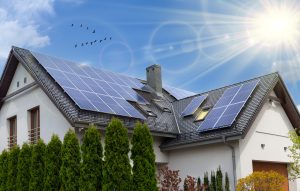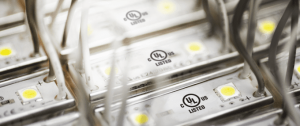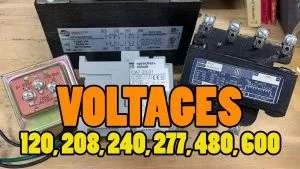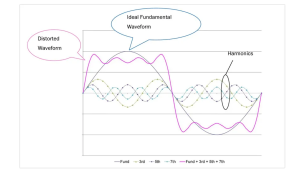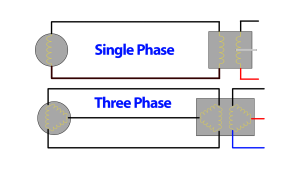As solar energy adoption grows, electricians are increasingly encountering various types of solar energy systems, including grid-tied, off-grid, and hybrid configurations. Each system has unique characteristics, applications, and components, particularly when it comes to inverters and backup battery energy storage systems (BESS). Understanding these distinctions is essential for electricians working with solar installations. This article explores hybrid vs off grid solar systems, their differences, and the technologies that power them.
Types of Solar Energy Systems
1. Grid-Tied Solar Systems
Grid-tied systems are the most common type of solar installation seen installed on homes across America. They are directly connected to the utility grid and rely on it as an alternative energy source, rather than a backup source. A grid-tied system is constantly tied to the utility grid, and therefore dependent upon it. If power is lost from the utility the solar panels may still power some equipment and devices, but without a battery system installed there is no way for the generated solar energy to be stored as backup power.
The benefit of a grid-tied solar system is energy savings. Not all of your home or business is reliant on utility power, as some of the circuits in the building are fed from solar, which is free energy. In addition, grid-tied systems often use two-way meters for “net metering” which allows any excess energy generated to go back to the power grid. This allows solar users to get paid by the utility for injecting more power into the grid which takes some of the load off of their generation systems. Not all states offer rewards for excess generation though, so check your state before installing one of these systems so you know whether or not you’ll earn money with net metering. The down-side is that if utility power is lost, you’re a bit up a creek for the rest of your power needs until it is reconnected.
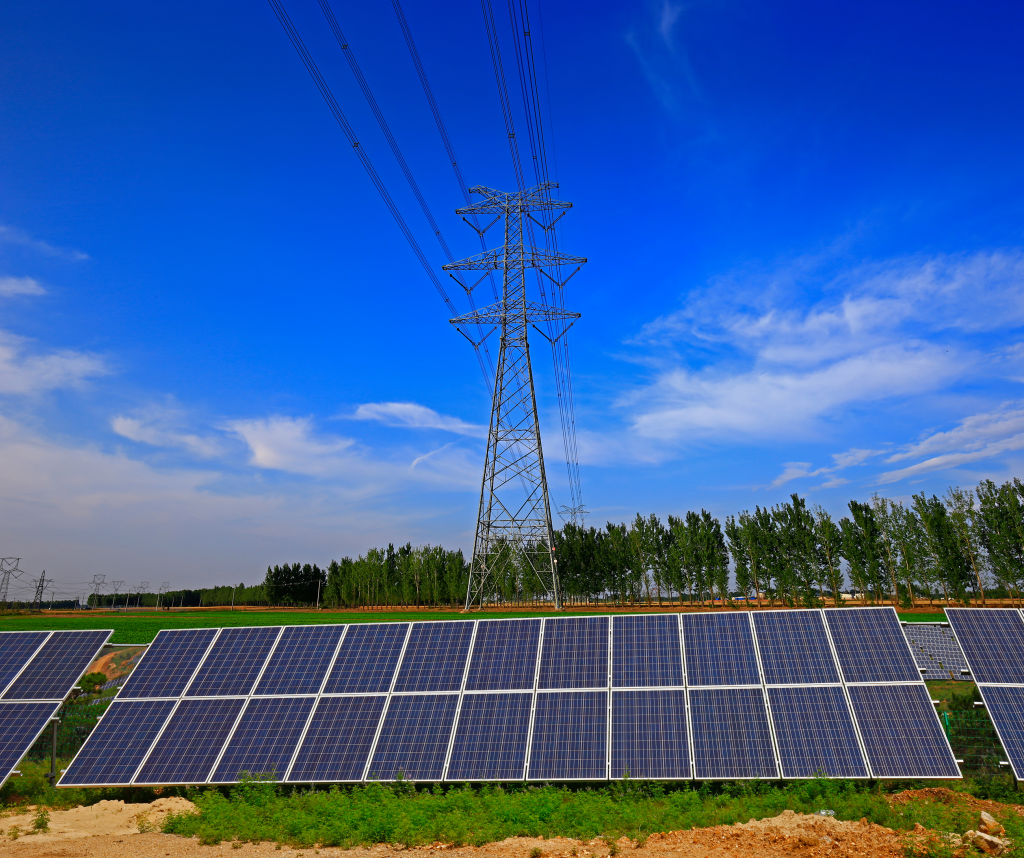
Key Features:
- No Battery Storage: Most grid-tied systems don’t include batteries. Instead, they send excess electricity generated by solar panels back to the grid.
- Two-Way Metering: Also known as net metering, this process credits the system owner for the excess energy sent to the grid, reducing their overall energy bill.
- Reliance on the Grid: Grid-tied systems depend on the utility grid to supply electricity when solar production is low (e.g., at night or on cloudy days).
Benefits for Electricians:
- Simpler installations compared to systems with batteries.
- Integration with existing electrical infrastructure.
2. Off-Grid Solar Systems
Off-grid systems operate independently of the utility grid, making them suitable for remote locations where grid access is unavailable or impractical. Most YouTube channels out there today which show solar installs are DIY installers putting panels on tiny-homes or remote, off-grid dwellings which do not require a tie in to the utility grid. For that, electricians need to be involved because the utility system and dwelling electrical systems need to be inspected in order for power to be delivered. So a benefit of off-grid systems is often they’re low voltage, and don’t require hiring an electrician to install. With tiny-homes, often there’s very little electrical consumption so smaller DIY kits can be purchased and installed by homeowners or DIY enthusiasts, without needing permitting and inspection.
As with grid-tied systems the only functionality off-grids offer is direct power from the panels and inverter while the sun is out; unless an added battery system is also installed. Without a battery system attached, there’s no way for energy to be stored and used as a backup when needed. It also means you only get power during the day. So installing battery systems are an even better idea for all systems, really.

Key Features:
- Battery Storage: Off-grid systems require a BESS to store excess energy generated during the day for use at night or during low-sunlight periods. It’s not absolutely necessary, but really inconvenient without batteries.
- Independent Operation: These systems are self-sufficient and must generate enough power to meet all energy needs.
Challenges for Electricians:
- System Design: Off-grid systems must be carefully sized to ensure sufficient energy generation and storage capacity.
- Cost: The inclusion of batteries significantly increases the upfront cost.
- Maintenance: Regular maintenance is required to ensure optimal battery performance.
3. Hybrid Solar Systems
Hybrid solar systems combine features of both grid-tied and off-grid systems. They are connected to the utility grid but also include a BESS for added energy independence. These systems generally cost more because you have to buy the panels, the inverter, the two-way meter, a bank of batteries to store energy, and some means of either manually or automatically transferring between power sources. That added cost, however comes with added benefits. Hybrid systems that are set up right, offer a completely hands free system which not only minimizes your bills from the utility grid, but also allows instantaneous backup power during a power outage.
The really nice part is that the solar charges the batteries throughout the day, uses the batteries during an outage, and allow for an instant transfer when power is lost. In most cases the battery system is so fast you don’t even notice power went out. They often come with an inverter which has a built in automatic transfer switch (ATS) which senses power has been lost and transfers from utility to battery without you having to intervene. Battery storage systems are similar to uninterruptible power supplies (UPS) in that way, however a UPS comes with more functionality such as voltage regulation and surge protection, which BESS’s do not. So if you want a true “backup” system which saves you money and operates completely independently a hybrid system with an automatic transfer switch is a killer option.
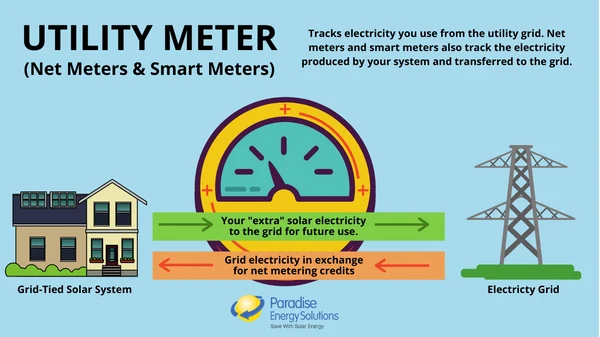
Key Features:
- Battery Backup: Provides stored energy during grid outages or low-sunlight periods.
- Grid Support: Allows users to draw power from the grid when needed and send excess energy back for credits through net metering.
- Versatility: Offers the flexibility of grid reliance with the resilience of battery storage.
Advantages for Electricians:
- Increasingly popular among homeowners and businesses for their balance of reliability and independence.
- Opportunities for advanced installations involving modern inverters and smart energy management systems.
Two-Way Metering: A Key Feature of Grid-Tied and Hybrid Systems
Two-way metering, or net metering, is a mechanism that allows solar system owners to send excess energy back to the utility grid in exchange for credits. These credits can offset the cost of electricity drawn from the grid, reducing overall utility bills.
How It Works:
- When solar panels generate more electricity than the system uses, the excess energy is fed into the grid.
- The utility company tracks the exported energy using a bi-directional meter.
- Credits are applied to the owner’s utility bill based on the amount of energy exported.
For electricians, understanding two-way metering is essential for designing and integrating grid-tied and hybrid systems. Proper installation of metering equipment ensures compliance with local regulations and maximizes system efficiency.
Inverters and Battery Energy Storage Systems (BESS)
Inverters and batteries are essential components in solar energy systems, enabling the conversion and storage of energy. Since DC power is fed in from a solar panel, and a vacuum cleaner and laptop charger require AC power to plug into, there needs to be a way to invert the incoming DC, to AC. Inverters are essential for converting the direct current (DC) generated by solar panels into alternating current (AC), which is used by most appliances and electrical systems. Different inverter types are suited to different solar system configurations:
1. String Inverters
- Common in grid-tied systems.
- Centralized device that connects to multiple solar panels.
- Simpler and cost-effective but less efficient when panels face shading or orientation issues.
2. Microinverters
- Installed on each solar panel for individual energy conversion.
- Ideal for systems with shading or varying panel orientations.
- Typically used in grid-tied and hybrid systems.
3. Hybrid Inverters
- Designed for systems with battery storage.
- Manages the flow of electricity between solar panels, batteries, and the grid.
- A key component in hybrid systems.
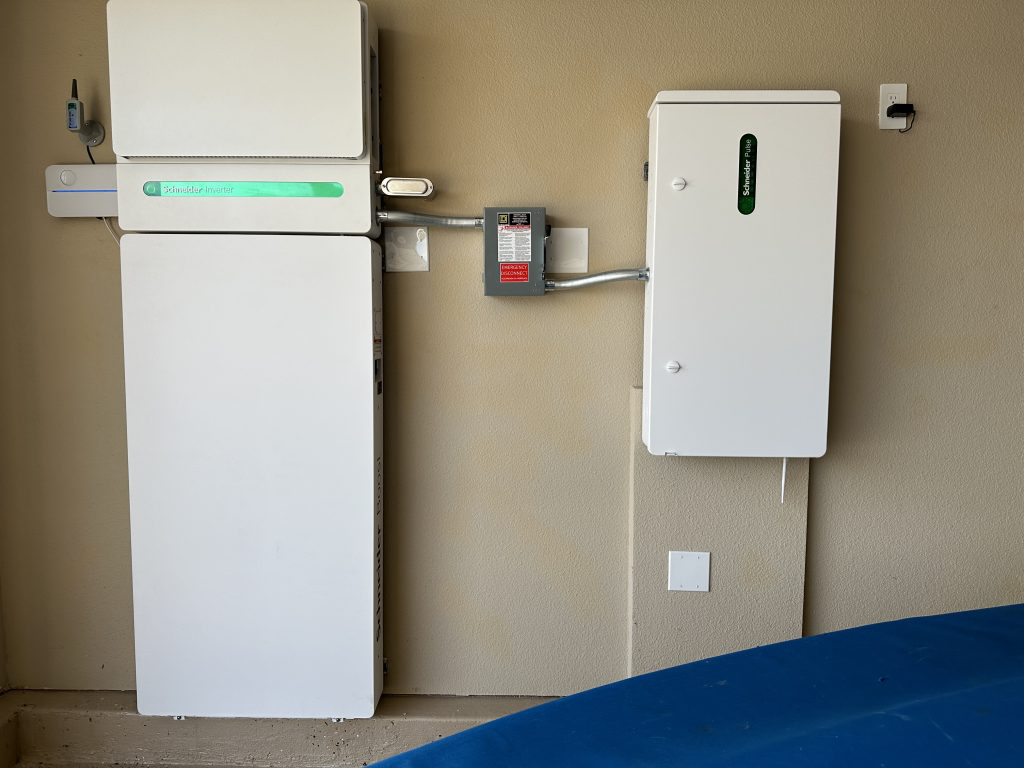
Battery Energy Storage Systems (BESS)
A Battery Energy Storage System (BESS) is one of many types of Energy Storage Systems (ESS) that stores excess solar energy for later use. This technology is essential for off-grid systems and increasingly common in hybrid setups.
Types of Batteries:
- Lead-Acid Batteries: Affordable but have shorter lifespans and lower efficiency compared to newer options.
- Lithium-Ion Batteries: The most popular choice for modern solar installations due to their higher efficiency, longer lifespan, and smaller size.
Functions of a BESS:
- Energy Backup: Provides electricity during outages or low solar production.
- Load Shifting: Stores energy during low-demand periods and supplies it during peak demand.
- Grid Independence: Reduces reliance on the utility grid in hybrid and off-grid systems.
Conclusion
Understanding the differences between hybrid and off-grid solar systems is crucial for electricians in today’s evolving energy landscape. Hybrid systems offer the versatility of grid reliance with the added security of battery storage, while off-grid systems provide complete independence. As inverters and battery energy storage systems play a pivotal role in these setups, mastering their operation and integration is essential for efficient installations.


